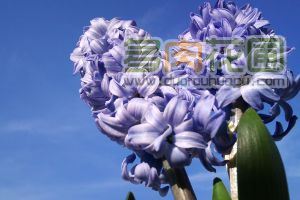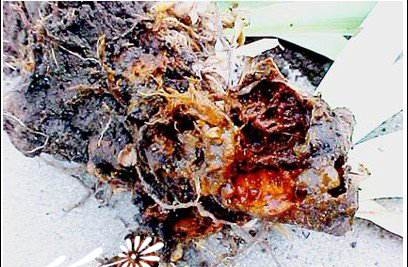Control methods of hyacinth mosaic disease
[symptoms] the leaves were damaged, showing yellow and green mosaic shape, gradually developed into stripes and patches, and in severe cases, the leaves were yellowed and twisted; the bulbs grew poorly and became smaller; the flowers were broken, shrunk and not bright; and the plants showed dwarfing.
[pathogen and incidence regularity] is a viral disease, and the pathogen is hyacinth mosaic virus HMV. According to foreign reports, tulip broken color virus, daffodil mosaic virus, tobacco fragility virus, lily latent virus, evergreen mosaic virus and cucumber mosaic virus can cause harm to hyacinth. Hyacinth mosaic virus is transmitted by mechanical friction, and potato aphids can also transmit viruses from other poisonous plants to hyacinths.
[prevention and control methods]
1. Remove the diseased plants in time and avoid propagation with poisonous bulbs.
2. Eliminate other poisonous plants in hyacinth cultivation area.
3. Strengthen the control of aphids and other vector pests.
Symptoms and control of hyacinth mosaic disease

Symptoms of hyacinth mosaic disease
In the early stage of the disease, the symptoms were mild, the glossiness of leaves decreased, fine spots appeared, and brown stripes or patches were gradually formed. In severe cases, the whole leaf is yellowed and twisted, the plant is short, the flowering period is non-flowering or the flower is small, and the seed bulb is degenerated.
Pathogen analysis
The main pathogen of mosaic disease is mosaic virus, which can mutate at 68 ℃. In addition, other flower viruses such as tulips, daffodils and lilies can cause hyacinth mosaic disease.
Morbidity regularity
In its natural state, the virus infects hyacinth. This kind of virus is transmitted mechanically, and branches and leaves can be infected when they come into contact with germs. if diseases and insect pests occur, such as nematodes and aphids, they can spread.
Prevention and cure method
Mosaic disease can not be cured, it can only be prevented. If you pay more attention to maintenance, you will be able to worry less.
Before planting, ① should select the bulbs of disease-free plants to plant, and disinfect the bulbs before planting.
Before planting ②, disinfect the soil and irrigate Bordeaux solution.
③ can kill pests and pathogens in time.
Once ④ found that there are small spots on the leaves, immediately spray antivirus, timely clean up the diseased leaves to avoid cross-infection.
⑤ should not be planted in the same pot with other plants, but should be maintained separately. Plants at home should pay more attention not to let hyacinths get close to tulips, daffodils, lilies and other plants, so as not to spread diseases to each other.
Hyacinth mosaic disease
[distribution] Shanghai.
[symptoms] light flowers and leaves at the initial stage, and later developed into stripes and patches; in severe cases, the leaves yellowed and twisted, the plants were short, the bulbs became smaller, and the flowers were broken, shrunk, and not bright.
Hyacinth mosaic disease is caused by hyacinth mosaic virus (hyacinthmosaic virus,HMV). The virus is a line-shaped particle with a length of 700Mel 725nm.
[incidence regularity] the lethal temperature of hyacinth mosaic virus was 68 ℃. Hyacinth mosaic is transmitted mechanically. In addition, through the potato aphid, the virus from other poisonous plants can be transmitted to hyacinth, or from hyacinth to plants such as Tiger Euphorbia.
[control methods] pulling out diseased plants; leaving seeds without the bulbs of poisonous plants; in addition, strengthening the control of vector insects such as aphids can also play a certain control effect.
- Prev

Control methods of Sclerotinia sclerotiorum
[symptom] damage to leaves and bulbs is a common disease of hyacinth. The growth of the infected plants was blocked and the growth was retarded. The leaves of the diseased plants were grayish yellow, and with the development of the disease, the leaves gradually withered and easily detached from the bulb; the interior of the susceptible bulb changed color and rotted to varying degrees, resulting in white hyphae.
- Next

Control methods of hyacinth root rot
Hyacinth cultivation areas occur from time to time, endangering hyacinth and other flowers, resulting in root rot. After the symptom plant is damaged, the growth is weak, dwarf, can not blossom normally, dig up the soil, it can be seen that most or all of the roots on the corm rot. The pathogen of the disease is Fusarium, which belongs to fungi. The pathogen overwintered in the remnant of the diseased plant.
Related
- Fuxing push coffee new agricultural production and marketing class: lack of small-scale processing plants
- Jujube rice field leisure farm deep ploughing Yilan for five years to create a space for organic food and play
- Nongyu Farm-A trial of organic papaya for brave women with advanced technology
- Four points for attention in the prevention and control of diseases and insect pests of edible fungi
- How to add nutrient solution to Edible Fungi
- Is there any good way to control edible fungus mites?
- Open Inoculation Technology of Edible Fungi
- Is there any clever way to use fertilizer for edible fungus in winter?
- What agents are used to kill the pathogens of edible fungi in the mushroom shed?
- Rapid drying of Edible Fungi

